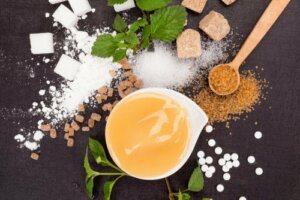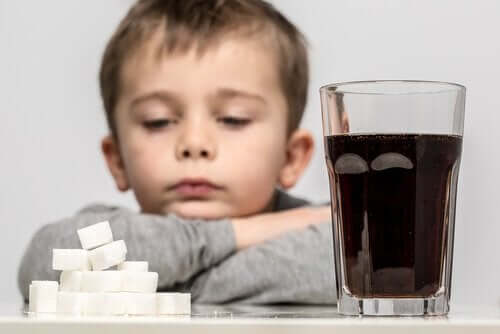Are Artificial Sweeteners Suitable for Children?

Excess weight and obesity in children are an epidemic. As a result, artificial sweeteners are replacing more and more sugar in children’s diets. But are synthetic sweeteners really suitable for children?
Artificial sweeteners for children
For years, we’ve been using “low” or no-calorie sweeteners as substitutes for all or part of the sugar content in foods and beverages. And in recent decades, their consumption has increased in both adults and young people.
Experts have linked their use to dietary alternatives in weight control or diabetes and also the prevention of cavities. However, some studies question these possible benefits, in adults and children alike.
Artificial sweeteners for children and their relationship to health
Weight
Many think that sweeteners help with weight loss. And yes, it’s true that they have fewer calories than sugar. But even so, they don’t always help us lose weight or reduce the risk of diabetes.

Some observational studies have linked the increase in Body Mass Index (BMI) with the consumption of heat-enhancing sweeteners. However, we shouldn’t interpret these data as proof of causality. Rather, we should interpret them as evidence of the increased likelihood of consumption among those with obesity and sedentary lifestyles.
The substitution of sugar by sweeteners doesn’t necessarily imply a lower overall caloric intake. What’s more, it could induce unbalanced eating behaviors with high consumption of sweetened and low-calorie products.
Glucose intolerance
The body reacts to these synthetic sweeteners differently than it does to sugar. That’s because they can have effects on glucose metabolism, intestinal microbiota, and appetite control Therefore, they can also have negative effects on children.
Intake of sweeteners and sugar may induce a neural response that conditions faster absorption of sugars. This, at the same time, increases the secretion of glucagon-related peptides, or insulin. Thus, glucose intolerance may develop through changes in the intestinal microbiota.
Dental damage
In the child population, in addition to fluoride deficiency, cavities are still frequent. After the ingestion of sweet foods, there’s usually no adequate oral hygiene. At the same time, in infants, the prolonged consumption of juices or other fructose or sucrose-rich drinks in their bottle increases the risk of dental damage.
Among the sweeteners, polyalcoholic sugars or sucralose, among others, have been declared as having healthy properties to avoid this pathology.
Artificial sweeteners for children: Consumption recommendations
Referring to children, the American Dietetic Association stated that artificial sweeteners are safe to use within the Recommended Daily Intake range. The American Academy of Pediatrics stated that the study of artificial sweeteners for use in children has been inadequate. Therefore, they shouldn’t form a significant part of the diet.

The committee also states that artificial sweeteners are safe in the general population, including pregnant women. However, children should only consume these types of additives as an alternative when other forms of obesity prevention aren’t sufficient.
Finally, the committee points out that the consumption of sweeteners within a moderate and balanced diet can help limit the consumption of refined sugar. At the same time, they contribute to the prevention of diseases such as obesity and diabetes.
Conclusion
As we’ve seen, according to studies and recommendations from experts, sweeteners can modify certain physiological mechanisms in both children and adults.
However, since there are no conclusive studies, it’s better to consume them in moderation and not regularly as a sugar substitute. The best option is for our children to consume food naturally from an early age, so that they get used to its natural flavor.
Excess weight and obesity in children are an epidemic. As a result, artificial sweeteners are replacing more and more sugar in children’s diets. But are synthetic sweeteners really suitable for children?
Artificial sweeteners for children
For years, we’ve been using “low” or no-calorie sweeteners as substitutes for all or part of the sugar content in foods and beverages. And in recent decades, their consumption has increased in both adults and young people.
Experts have linked their use to dietary alternatives in weight control or diabetes and also the prevention of cavities. However, some studies question these possible benefits, in adults and children alike.
Artificial sweeteners for children and their relationship to health
Weight
Many think that sweeteners help with weight loss. And yes, it’s true that they have fewer calories than sugar. But even so, they don’t always help us lose weight or reduce the risk of diabetes.

Some observational studies have linked the increase in Body Mass Index (BMI) with the consumption of heat-enhancing sweeteners. However, we shouldn’t interpret these data as proof of causality. Rather, we should interpret them as evidence of the increased likelihood of consumption among those with obesity and sedentary lifestyles.
The substitution of sugar by sweeteners doesn’t necessarily imply a lower overall caloric intake. What’s more, it could induce unbalanced eating behaviors with high consumption of sweetened and low-calorie products.
Glucose intolerance
The body reacts to these synthetic sweeteners differently than it does to sugar. That’s because they can have effects on glucose metabolism, intestinal microbiota, and appetite control Therefore, they can also have negative effects on children.
Intake of sweeteners and sugar may induce a neural response that conditions faster absorption of sugars. This, at the same time, increases the secretion of glucagon-related peptides, or insulin. Thus, glucose intolerance may develop through changes in the intestinal microbiota.
Dental damage
In the child population, in addition to fluoride deficiency, cavities are still frequent. After the ingestion of sweet foods, there’s usually no adequate oral hygiene. At the same time, in infants, the prolonged consumption of juices or other fructose or sucrose-rich drinks in their bottle increases the risk of dental damage.
Among the sweeteners, polyalcoholic sugars or sucralose, among others, have been declared as having healthy properties to avoid this pathology.
Artificial sweeteners for children: Consumption recommendations
Referring to children, the American Dietetic Association stated that artificial sweeteners are safe to use within the Recommended Daily Intake range. The American Academy of Pediatrics stated that the study of artificial sweeteners for use in children has been inadequate. Therefore, they shouldn’t form a significant part of the diet.

The committee also states that artificial sweeteners are safe in the general population, including pregnant women. However, children should only consume these types of additives as an alternative when other forms of obesity prevention aren’t sufficient.
Finally, the committee points out that the consumption of sweeteners within a moderate and balanced diet can help limit the consumption of refined sugar. At the same time, they contribute to the prevention of diseases such as obesity and diabetes.
Conclusion
As we’ve seen, according to studies and recommendations from experts, sweeteners can modify certain physiological mechanisms in both children and adults.
However, since there are no conclusive studies, it’s better to consume them in moderation and not regularly as a sugar substitute. The best option is for our children to consume food naturally from an early age, so that they get used to its natural flavor.
All cited sources were thoroughly reviewed by our team to ensure their quality, reliability, currency, and validity. The bibliography of this article was considered reliable and of academic or scientific accuracy.
- Azad, M. B., Abou-Setta, A. M., Chauhan, B. F., Rabbani, R., Lys, J., Copstein, L., … Zarychanski, R. (2017). Nonnutritive sweeteners and cardiometabolic health: a systematic review and meta-analysis of randomized controlled trials and prospective cohort studies. CMAJ : Canadian Medical Association journal = journal de l’Association medicale canadienne, 189(28), E929–E939. doi:10.1503/cmaj.161390
- Suez, J., Korem, T., Zeevi, D., Zilberman-Schapira, G., Thaiss, C. A., Maza, O., … Elinav, E. (2014). Artificial sweeteners induce glucose intolerance by altering the gut microbiota. Nature, 514(7521), 181–186. doi:10.1038/nature13793
- Reid, A. E., Chauhan, B. F., Rabbani, R., Lys, J., Copstein, L., Mann, A., … Azad, M. B. (2016). Early Exposure to Nonnutritive Sweeteners and Long-term Metabolic Health: A Systematic Review. Pediatrics, 137(3), e20153603. doi:10.1542/peds.2015-3603
- Gil-Campos, M., González, M. S. J., Martín, J. D., de la Asociación, C. D. N., & de Pediatría, E. (2015, November). Uso de azúcares y edulcorantes en la alimentación del niño. Recomendaciones del Comité de Nutrición de la Asociación Española de Pediatría. In Anales de Pediatría (Vol. 83, No. 5, pp. 353-e1). Elsevier Doyma.
- Wakida-Kuzunoki, G. H., Aguiñaga-Villaseñor, R. G., Avilés-Cobián, R., Baeza-Bacab, M. A., Cavagnari, B. M., del Castillo-Ruíz, V., … & Molina-Seguí, F. (2018). Edulcorantes no calóricos en la edad pediátrica: análisis de la evidencia científica. Revista Mexicana de Pediatría, 84(S1), 3-23.
This text is provided for informational purposes only and does not replace consultation with a professional. If in doubt, consult your specialist.








